What is Influencer Marketing – Definition, Guide, and Helpful Examples
Table of contents
Influencer marketing is the next level of word-of-mouth marketing. Influencers have the abnormal power of affecting purchase decisions and deciding what is going to be trending next. Your goal as a marketer is to encourage the influencer that your brand is the one they want to advertise. Here’s what you need to know about influencer marketing in 2023.
In this article, we will be talking generally about what influencer marketing is, but we will also discuss how to perform an influencer marketing campaign. We will also analyze some social media campaigns involving influencers and check where to find the right brand ambassadors.
Before you read: perhaps you will be interested in our report on Top 100 Marketing Influencers.
What is influencer marketing – a definition
If you already have a brief knowledge of who is an influencer, and the basics of influencer marketing, you can skip to the next chapter.
First, we need to define an influencer. It’s a persona, usually very active in various social media channels, that has a lot of followers. Think of them as modern-day celebrities. Those are individuals that other people look up to.
Various companies quickly discovered the power of word-of-mouth marketing, and influencer marketing works just like that – brands are promoting products by sharing them with popular people. Later, these people talk about the goods in Instagram Stories, YouTube videos, or Twitter tweets and the campaign is on.
Many brands use influencer marketing mostly to raise awareness, but it’s also useful while launching new products or campaigns.
A simple example of influencer marketing: a brand finds a popular Instagram account, and sends them a product. Next, the influencer posts a picture with said product and shares a discount code to use at the manufacturer’s site.
The followers see the product with a short review and use the code to make a purchase. That’s influencer marketing. Interested? Read more to learn how to prepare a successful influencer marketing campaign.
Influencer marketing – a social media strategy involving product placement and brand mentions from people considered to be experts in their field or defined as influencers by the sheer number of followers.
The state of influencer marketing in 2023
Many would argue, that influencer marketing was much easier 10 years ago, and nowadays it’s just not that profitable. It is true that social media are much more saturated now, and it’s definitely harder to break through to the top for upcoming influencers.
But on the other hand, Instagram and TikTok are now at the peak of popularity (the later maybe even before its peak), because with the advancement of the smartphones everybody can have these app on their home screen.
Find out who’s talking about your brand. Try our tool with a 14-day free trial.
This means, that influencer marketing is more relevant than ever, because nobody wants to read classic advertisements anymore. Sure, investing in paid advertisement is still profitable and by any means, I’m not advising to ditch Facebook Ads and switch to influencer marketing only. But influencer campaigns can bring you a lot of juicy traffic.
So how much are influencers worth now? Let’s proceed to the next chapter.
Influencer marketing statistics
Influencer marketing is estimated to be worth more than $10 billion in 2021. Some people predicted it will decrease due to the COVID-19 pandemic, but it only grew stronger. This single number means you should at least be aware of the phenomenon if you want to be an up-to-date marketer.
More than half of brands have a standalone budget for content marketing, and a majority of them invest in influencer marketing, according to a study conducted by Influencer Media Hub.
Linqia administered their own survey, and it turns out more than of 70% enterprise marketers wanted to increase their budget in 2021 (compared to the previous year). The same study says Instagram stays as the most popular platform for influencer marketing, followed by TikTok, which is quickly gaining reputation. What’s also interesting, is the rising demand for vertical videos, as this format is necessary for successful Instagram Stories campaigns, and is considered more mobile-friendly.
Most (77%) of the marketers from the Linqia survey pointed at engagement as the key metric for measuring the success of campaigns.
Types of social media influencers & channels
Influencer tiers
Generally, we distinguish a few influencer types, defined by the number of followers.
Nano influencers
At the grassroots level, nano influencers have the smallest follower bases. They often focus on local markets or specific niches. Despite their size, they boast high levels of authenticity and engagement. In fact, nano-influencers have the highest engagement rates, making them genuine and sincere partners for niche marketing efforts.
Read more: There’s a lot more about nano influencers you should know if you want to include them in your campaign. We’ve prepared a whole other article about nano influencers, go check it out!
Micro influencers
A step above nano influencers, micro influencers have larger followings and can be an excellent entry point for your influencer marketing strategy. They strike a balance between reach and relatability, often yielding high engagement rates, a trend that is increasingly favored by brands.
Read more: Again, if you would like to try an influencer marketing campaign with this type of people, we have a full article about micro influencers for you!
Mid-tier influencers
With substantial followings and a loyal fan base, mid-tier influencers are seasoned in brand partnerships. They offer a blend of credibility and reach, often serving as effective brand ambassadors.
Macro influencers
Boasting significant followings, macro influencers include well-known celebrities and public figures. While engaging them can be challenging due to potential disinterest in campaigns or high fees, their influence is undeniable. They can dramatically increase brand visibility and are often sought after for their broad appeal.
Mega influencers
At the pinnacle are mega influencers, predominantly A-list celebrities. They command hefty fees and are typically approached by large corporations for their star power. Although alluring, they are not the usual go-to for influencer marketing due to their high costs and alternative income streams.
Here’s a simple graph that shows influencer tiers based on the number of followers at Instagram (the most popular app for influencers):
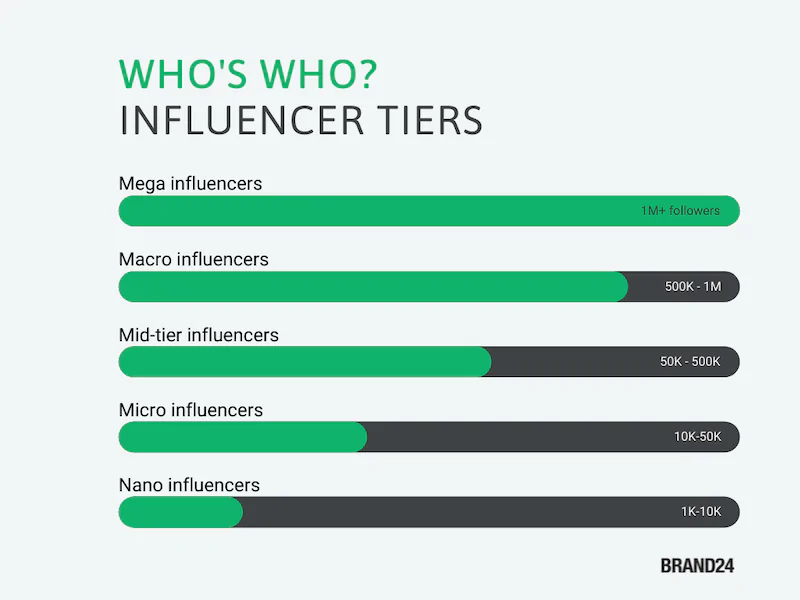
Brand24 helps you identify the most influential people in your market niche.
Social media platforms breakdown
Influencer marketing varies significantly across social media platforms. While top influencers may have a presence on multiple platforms, many focus their efforts on just one, like YouTube or TikTok.
Your influencer marketing strategy must pinpoint the most effective platform for your goals and the best return on investment (ROI). Fashion products, for instance, often see high engagement on Instagram, whereas tech reviews might gain more traction on YouTube.
Here’s what you need to know about each channel:
As one of the older platforms, Facebook’s younger demographic is dwindling, and the space is increasingly filled with sponsored content. Organic reach is challenging amidst the ads and clutter.
While not the prime choice for starting an influencer campaign, with a substantial budget for paid promotions, it can still yield results.
Often hailed as the hub for influencers, Instagram’s user base of approximately 1.4 billion in 2020 generated a remarkable $24 billion in revenue.
The platform’s visual nature makes it ideal for influencers, where a single post from a well-followed individual can have more impact than a series of traditional ads.
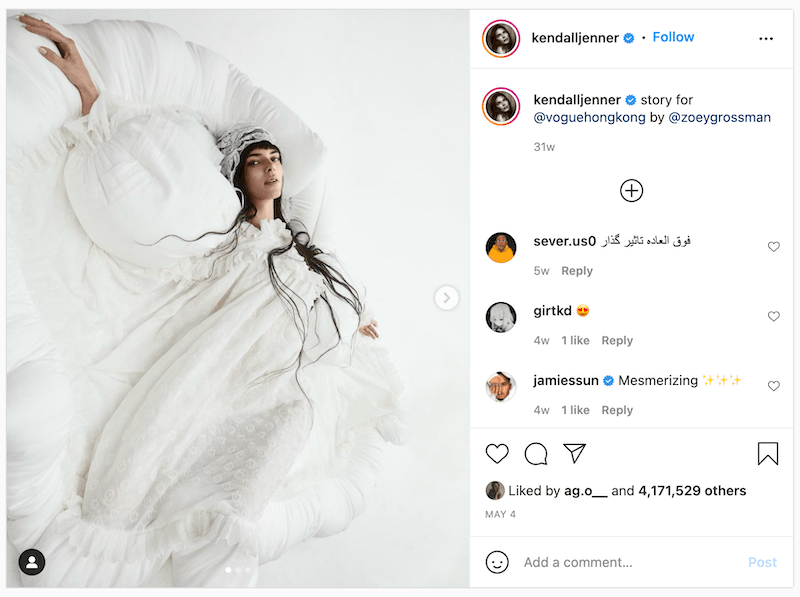
Read: How to Find Trending Hashtags on Instagram?
Twitter’s relatively smaller scale compared to giants like Instagram or Facebook doesn’t diminish its value in influencer marketing. It’s a mistake to overlook Twitter as a viable channel for generating traffic and enhancing brand visibility.
The platform’s approachability is its strength. Users on Twitter are accustomed to direct engagement and candid conversations, making it an ideal place for influencers to integrate brand mentions organically.
When influencers share about a new gadget or service, their followers are less likely to perceive it as overt advertising and more as a trusted recommendation.

Read more here: Twitter Influencers: How to Find Them + benchmarks
YouTube
YouTube reigns supreme in the realm of video content. Despite controversies, like the removal of the dislike button, YouTube’s dominance remains unchallenged. Alternatives like Vimeo or Dailymotion capture only a fraction of YouTube’s audience.
With specialized tools, identifying influencers in specific market sectors on YouTube is straightforward.
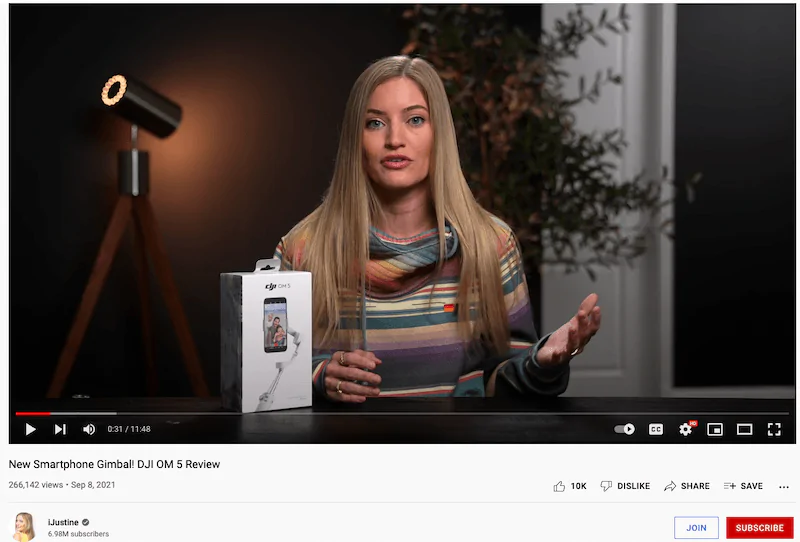
TikTok
TikTok’s meteoric rise in 2020 has seen it outpace other apps in download numbers. It’s on track to surpass Instagram’s user base, prompting many influencers to establish a presence on both platforms.
TikTok’s algorithm uniquely benefits smaller accounts, allowing them to achieve viral status and accumulate a substantial following swiftly, a feat more challenging on Instagram despite strategic hashtag use.
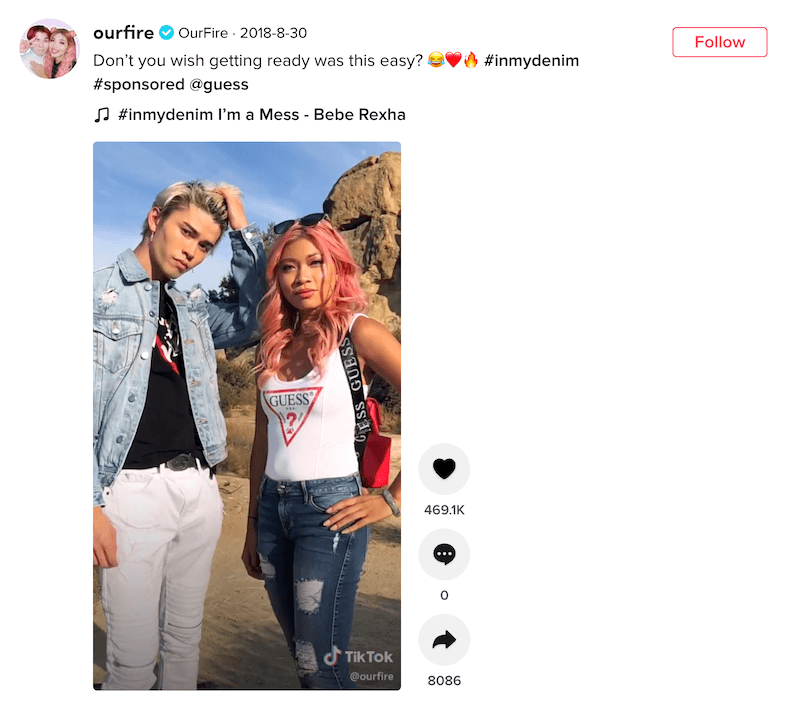
Read: Tiktok Monitoring Tools
Often underrated, Pinterest can be a powerhouse for driving quality traffic when leveraged in a well-crafted social media marketing campaign. The platform isn’t saturated with influencers, presenting an opportunity to partner with those who have cultivated a dedicated audience.
LinkedIn, the professional networking site, can also be a fertile ground for influencer marketing. Users frequent LinkedIn for industry-related content, professional insights, or job opportunities, making it a suitable platform for promoting professional tools or showcasing your brand as an exemplary workplace.
Other channels
Beyond the mainstream, niche social media channels exist, though they may not always align with the goals of a typical influencer marketing campaign.
Platforms like Tumblr, Snapchat, Vimeo, Reddit, and music-centric apps like Mixcloud or SoundCloud cater to specific audiences and interests.
Mark Zuckerberg’s announcement of Meta hints at a new social media era in the “metaverse.” The implications for influencer marketing in this virtual space are still unfolding, but forward-thinking brands are already strategizing for this next frontier.
Innovations like Clubhouse, which peaked in early 2021, demonstrate the dynamic nature of social media. Though its popularity waned, the concept of audio-only social interaction lives on, with platforms like Twitter Spaces exploring similar concepts.
The future may see the resurgence of such apps or the introduction of new challengers, keeping the influencer marketing industry in constant evolution.
Use the Brand24 tool to discover the right influencers, and reach your target audience.
How much does influencer marketing cost?
If you want to know the answer to this question, we need to take into consideration more than one thing.
First of all, the cost of your product. Are you giving away your goods for free to the influencer? Are you sharing a discount code they can post? There are a lot of ways to present your brand to a wider audience.
Secondly, not many influencers engage in partnerships for free. You can either ask for their rates (especially if you want to get celebrity endorsements on Facebook or Instagram posts from mega influencers) or decide on a budget and ask the influencer if they are open to the idea (works better with nano and micro influencers).
To be frank – there’s no right answer to how much your influencing campaign will cost. It’s all about your budget.
Affiliate marketing
For influencer affiliates, the cost is typically a combination of the product cost and commission rate. The commission rate can vary based on the influencer’s level of influence and engagement, and it’s important to establish clear expectations for the partnership.
If you’re a marketing influencer looking for new partnership opportunities, make sure to sign up for our partner program.
Read more: Brand24 Partner Program
How to prepare an influencer marketing strategy?
Influencer marketing involves a lot of planning beforehand, and later you can mostly only monitor the campaign and take notes.
- Define Your Goals: Start by outlining what you want to achieve with influencer marketing. Is it brand awareness, sales, or engagement?
- Identify Your Audience: Know who you want to target. Your influencer’s audience should align with your own.
- Discover Influencers: Use tools like Brand24 to find influencers, or search manually. Verify their followers are genuine.
- Outreach: Contact potential influencers. Be clear about your expectations and ensure they resonate with your brand values.
- Negotiate Terms: Discuss what you want from the collaboration. This could include post frequency, content style, and messaging.
- Create a Campaign Brief: Provide influencers with a detailed brief that includes campaign objectives, key messages, and any branded hashtags for tracking.
- Track Campaigns: Utilize tools like Brandwatch or Brand24 to monitor the campaign’s progress and measure its impact.
- Draft a Contract: Always formalize agreements with a contract. This protects both your brand and the influencer.
- Launch the Campaign: Kick off the campaign and monitor its progress, adjusting strategies as needed based on real-time feedback.
- Review and Optimize: After the campaign, analyze its success against your goals. Use these insights to refine future strategies.
Don’t forget about a contract, especially if you are paying the influencer for the advertisement. A contract is a safety tool for both the company and the person involved in creating the sponsored content. Should any problems appear later, the contract will be your way of resolving the conflict.
How to track influencer marketing campaigns?
Calculating ROI from an influencer marketing campaign can be difficult, because not always you can prepare unique links with UTM codes. Most marketers rely on engagement rate and website traffic to see how much clout their campaign generated.
First, and most obvious way of tracking the campaign is to visit the social profiles of influencers included, and check the engagement rate on promoted products. Then you can compare the data in Google Analytics or any other alternative to see the traffic sources on your website.
If it’s a simple e-commerce campaign, you will see the source of the sales in Google Analytics, and then you can easily estimate the ROI. Don’t forget about UTM parameters or similar tracking methods.
You can also use media monitoring tools to track how influencer content is resonating on the Web. Sentiment analysis apps will be most helpful. An example of such a tool is Brand24, where you can track branded hashtags and significant keywords, and generate reports with sentiment analysis. More on the tools in the next chapter.
How to find influencers?
Now you know quite a lot about influencer marketing strategy, but I still haven’t told you where to look for the right influencers.
The most obvious place are the relevant social media channels. Open your social media app of choice, browse hashtags or key phrases popular in your market and you are bound to find accounts with a large follower count and quite engaged audience.
But there are also other tools that are more convenient and accurate in identifying influencers. Here are some of them:
Brand24
I’m sure you are not surprised to find our tool in this listing. After all, why would we cover influencer marketing if we didn’t have the means to follow and manage your influencer strategy.
Brand24 is a media monitoring tool. It collects brand mentions all over the Internet and creates custom reports. It also provides additional data, such as sentiment analysis, influencer score, and the number of followers (for social media posts). This is exactly what you need to find influencers if you want to start a campaign including an influencer program.
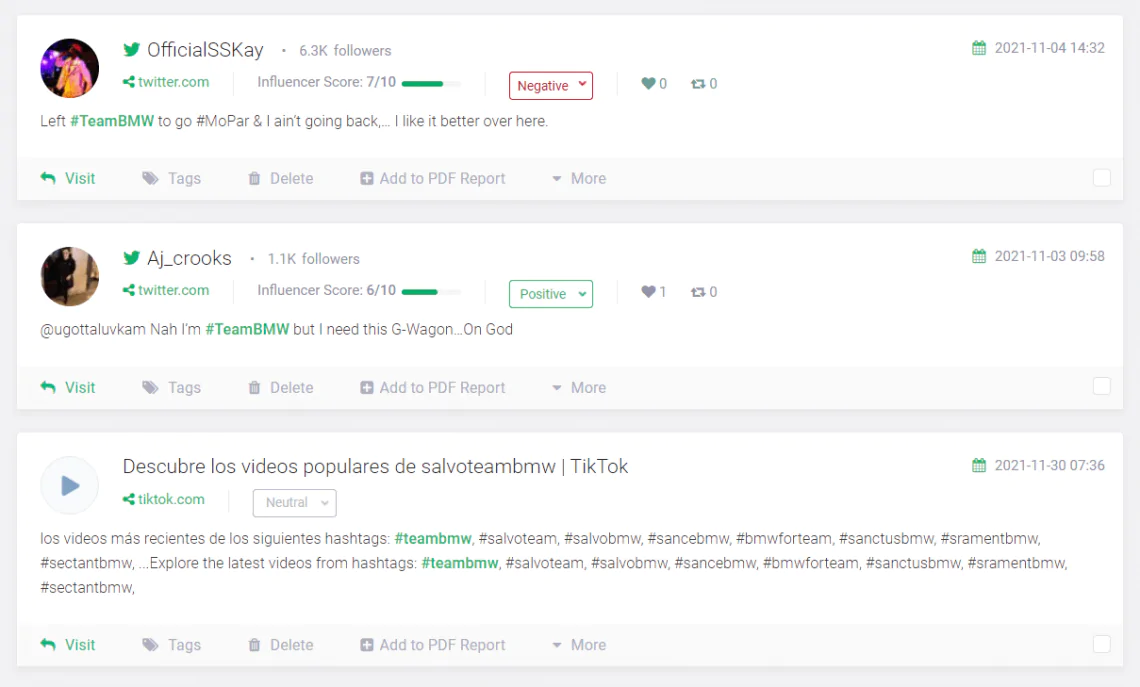
In Brand24 you are not limited to brand mentions. You can set up your project to collect mentions of keywords related to your target market. The influencer score and number of followers will tell you if the account is essential for the social media campaign.
The tool starts at $69 per month, but you can check the free trial anytime – no credit card required.
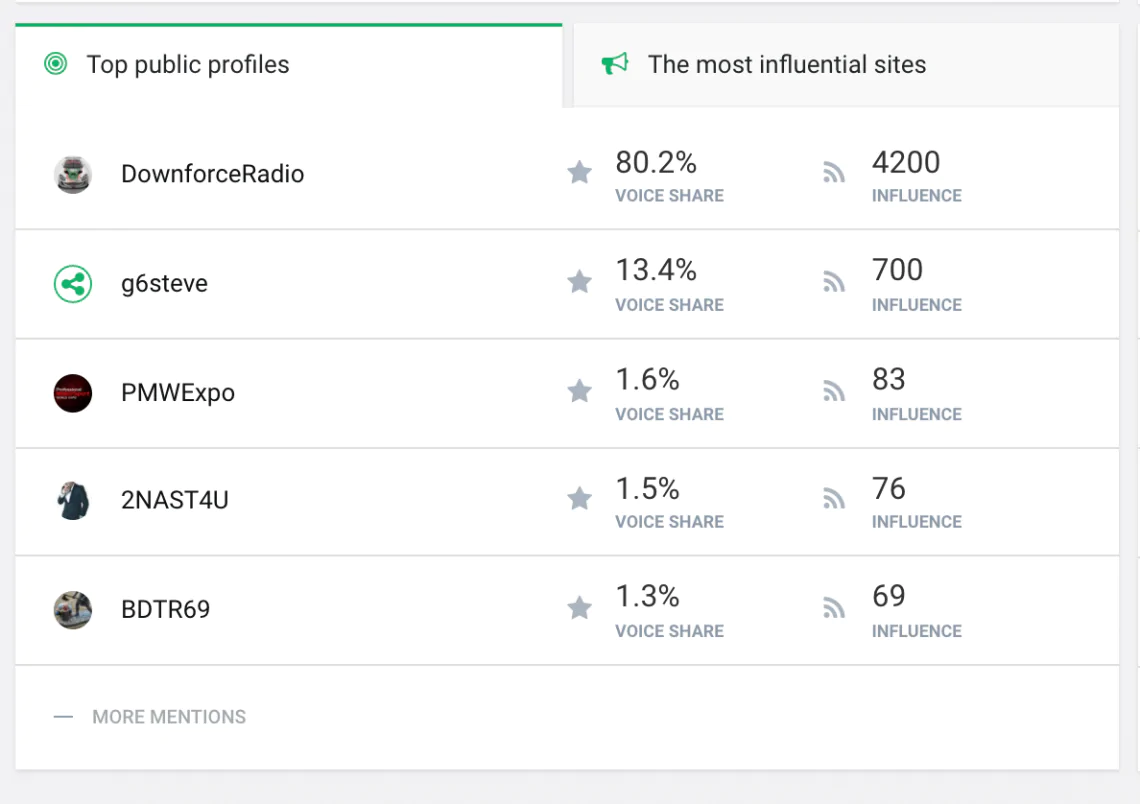
Brandwatch
Brandwatch works similarly to Brand24. It collects brand mentions and tracked keywords across the Internet, too. With Brandwatch it’s easy to follow conversations revolving around your company or market niche and to understand what potential customers think about your brand.
The downside of Brandwatch is the price, which is relatively high. That’s why the tool is recommended for large enterprises.
Check out: Brandwatch alternatives
Influencer Marketing Hub
A private media company from Denmark. Influencer Marketing Hub can be called influencer marketing experts. They provide a lot of useful information and data about influencer marketing. They also collect a list of agencies working with influencers.
Upfluence
Upfluence advertises itself as an all-in-one influencer marketing platform. Its main purpose is to create a digital place where brands can connect and collaborate with content creators all over the world.
The tools the company provides allow for easier management of influencer campaigns and affiliate programs.
Linqia
Another influencer marketing platform that makes promoted content creation easier.
This app will let you find and connect with the right influencers and gives you the tools to measure the success of your campaigns.
A lot of marketers struggle with calculating the ROI of an influencer campaign, and Linqia tries to make it a bit easier. They are also a great source for valuable information about this type of marketing tactic.
Influencer Marketing Agencies
There are also a lot of agencies that manage influencers.
GetHero is a popular influencer marketing agency in Poland that have very influential personas on their roster. Including Friz (3m followers), Wersow (2,7m followers), or Yoshi (300k followers).
Marketing agencies will help you identify influencers for your target audience, and will take care of contracts and communication.
You can try Brand24 for free – no card details required. Discover people influencing within your industry.
Read more: How to find influencers?
Examples of social media influencer campaigns
You know what influencer marketing is, know where to find influencers, and how to measure your success. If you are still not convinced but are still reading this article, it means that you are considering.
Here are some examples of good influencer marketing campaigns that may either convince you to pursue this way or give you some inspiration on how to sell branded content and increase sales with influencer and celebrity endorsements.
Nike
Big eCommerce brands like Nike don’t really need influencer marketing to raise brand awareness, but still, use social influence to boost sales. In 2012 they partnered with a very popular YouTuber Casey Neistat to make an ad for Nike+ FuelBand (an activity tracker).
Here’s what happened:
Well, after watching the video you might feel that Nike wasn’t really happy about how Casey spent the money. Or were they? Come to think of it, #MakeItCount and an activity tracker go really well together with traveling around the world.
The video generated more than 30M views and 300k upvotes. The general sentiment is very positive.
Daniel Wellington
The watchmaker Daniel Wellington used a micro influencer marketing strategy to promote their products via less popular Instagram accounts. For example, they partnered with @canadianbros, a profile for two lovely dogs.
And as you can see on the screenshot below, that’s not the only brand the owner of @canadianbros is promoting.
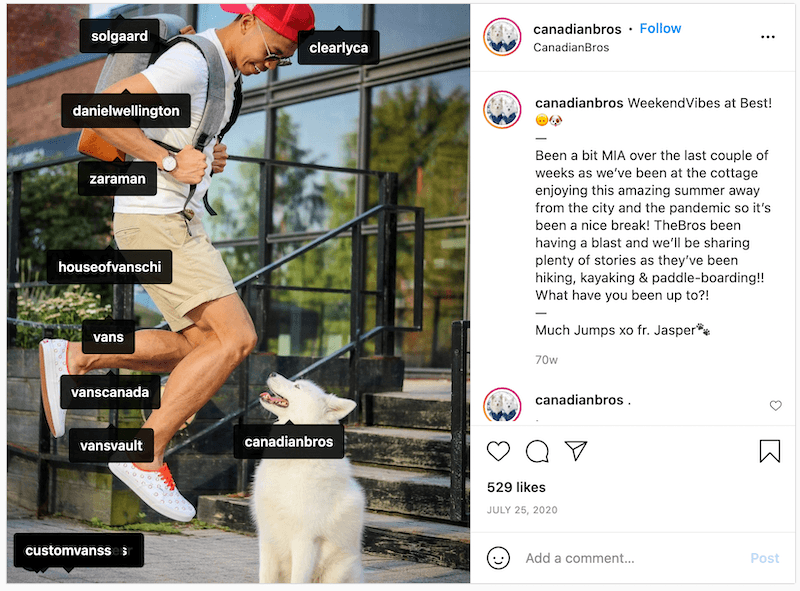
BMW
The car manufacturer also took the advantage of influencer marketing and involved the TikTok audience to showcase their work. The hashtags #TeamBMW and #THEiX3 were used by various influencers to show off their BMWs in a creative way.
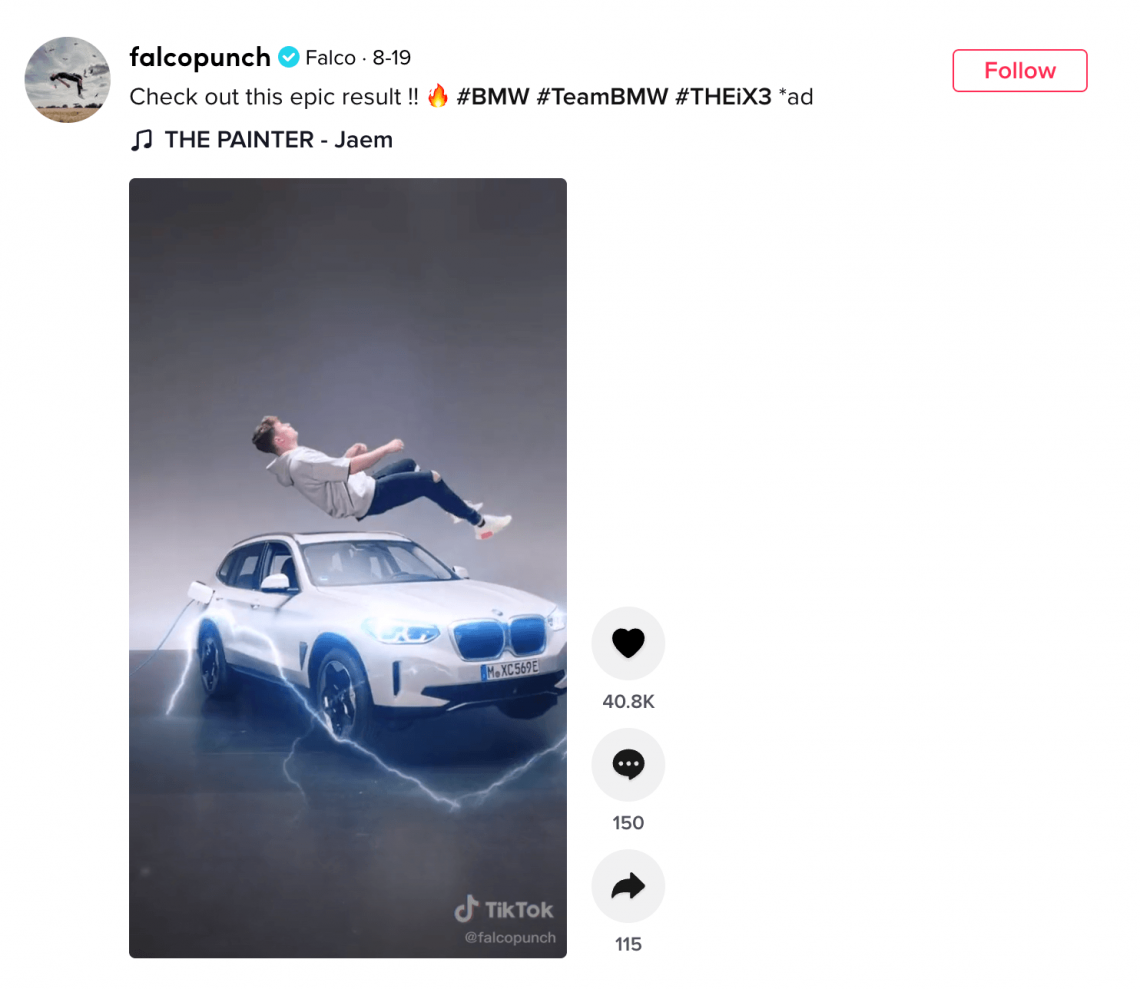
As we have discussed before, TikTok is now a great channel to gain a lot of views, even for smaller accounts, so you don’t have to organize big influencer marketing budgets for mega influencers and celebrities.
Why influencer marketing is still relevant in 2023?
You can use tools like Adblock to completely remove advertisements from your Internet browser, but you can’t adblock people (well, frankly speaking – you can, but that works in a different way).
Influencers will pop up in your feed every now and then, and if you are marketing a product it’s important to remember how people’s minds work. Instagram users are looking up to the influencers because they want to know what to wear, which phone to buy, and where to travel.
Every market sector can benefit from the right influencers.
As stated at the beginning of this article, influencer marketing is generating huge profits and a lot of brands are investing in this type of campaigns. There are good chances your competitors are already working with Instagram influencers and other creators, so you might not want to stay behind.
Conclusion
With various influencer marketing platforms available it’s now easier than ever to start working with influencers and start to promote your brand through this channel.
By now, you should get the gist of what influencer marketing really is. The numbers don’t lie – it’s very relevant to current times’ marketing strategy that every brand should at least consider.
The power of some people have to influence purchasing decisions is priceless.
To learn more about influencer marketing check the links in this article, and be sure to give Brand24 a chance.



